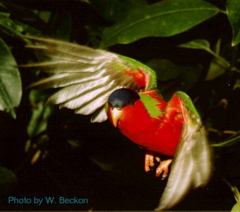Lory - Collared
Solitary Lory, Ruffed Lory Scientific Name: Vini solitarius
Sat, 5th July, 2025 - 7:47 pm GMT
Sponsor Ads:

Alternative Name
Solitary Lory, Ruffed Lory Scientific Name: Vini solitariusBasic Info
The Collared Lory is generally a hard-to-miss bird despite its small eight-inch length! Its plumage is red, and the lores, crown, and forehead are washed with a lovely contrasting dark purple color. The crown of females is a lighter blue color than that of male Collared Lories, and may even have a greenish coloring toward the posterior. Green feathering compliments the under-wing coverts, back, flight feathers, tail, and under-tail coverts of both sexes. The lower back and nape are lighter, a yellow-green color predominating in these areas. Collared Lories have violet-blue thighs and abdomens, and flesh colored legs and feet. Their bills are orange and the periopthalmic ring is narrow and black with a reddish brown iris. The Collared Lory derives its name from the bright green and red feathers of its mantle and neck, which are usually a little longer than the rest of its feathering. The green feathers can form fan formations on each side of the Lory's head if it chooses to flare them out!
Health
Specific Care Information: Relative Care Ease: Relatively Difficult When keeping Collared Lories, it is essential that they are kept clean. They tend to be prone to fungal infections and have been known to die suddenly with no apparent reason. While acclimating your Collared Lory, it is best to keep it above 75 degrees Fahrenheit. Later, they can tolerate low temperatures down to 68 degrees Fahrenheit. Breeding Collared Lories usually breed between July and December in the wild, nesting in coconut palms or rotten and dead stumps. Generally, Collared Lories lay two eggs, and will fiercely defend their nests from even non-threatening birds in the area! In captivity, they are fairly easy to breed and the incubation period lasts about four weeks. Although they have a clutch of two eggs, they will usually only rear one of the babies. Collared Lories usually fledge at about nine weeks of age. The nesting material should be changed regularly and will usually be best if placed in thick layers. Because Collared Lories may be even more meticulous about their foods during breeding season, it is probably best to offer them a variety of foods.Habitat
These colorful little birds are quite common and will occasionally visit gardens and coconut plantations. They inhabit moist, forested areas of the islands they live on.Behavior
Collared Lories are much loved by all that keep them, and just looking at one, it is very easy to fall instantly in love! These colorful little birds are truly striking as pets! In the wild, Collared Lories usually remain in pairs or small groups of between five and eight members. In particularly good feeding areas, groups of up to 50 birds may be seen! These Lories eat soft fruits like mangoes, nectar, pollen, and small insects like caterpillars. In flight, Collared Lories make two syllable noises though they are generally quiet while feeding. In captivity, they love to bathe. They will thrive in a colony environment, although if you do plan to keep more than one Collared Lory you should allow the birds plenty of space. Collared Lories in captivity eat honey, grain flakes, flowering branches, hard-boiled eggs, insects like mealworms, fruits like mangos, softened biscuits or pollen, and Brewer's Yeast. Many of these ingredients are combined in commercial Lory feeds. These birds are not very amenable to changes in their diets. The Collared Lory is agile and quick in flight and is not too noisy. It can be kept in an aviary indoors of 12 by six by six feet in dimension. Generally, it will be best kept with a roosting box of six by six by 24 inches.Origin
Fiji IslandsHistory
Collared Lories are native to northern parts of the Lau Archipelago in addition to the Fiji Islands. Also known as Ruffed Lories or Solitary Lories, Collared Lories are now protected from export on their native islands.Common Foods
These Lories eat soft fruits like mangoes, nectar, pollen, and small insects like caterpillars.Sponsor Ads:
"Everything that depends on the action of nature is by nature as good as it can be, and similarly everything that depends on art or any rational cause, and especially if it depends on the best of all causes. To entrust to chance what is greatest and most noble would be a very defective arrangement." -- Aristotle. Nicomachean Ethics.(I.1099b22). c. 325 BC.
Lory - Collared
Coded by: BGID® | ALL RIGHTS RESERVED Copyright © 2000-2025
Disclaimer | Privacy | Report Errors / Contact | Credits

 Preparing For China. China is growing their military. China Military Technology - can it keep up with the US?
Preparing For China. China is growing their military. China Military Technology - can it keep up with the US?  versus
versus 

 versus
versus 
 This Thread is about the North Korean Military itself - the kind of army, navy, and air force they have.
This Thread is about the North Korean Military itself - the kind of army, navy, and air force they have. 
 versus
versus 
 versus
versus  versus
versus